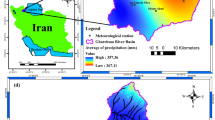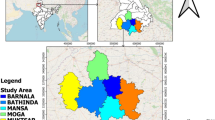Abstract
In recent years, the natural hydrology behaviors were greatly influenced by climate change. The relation between runoff and climate change are always the core of scientific hydrological study in arid region. This paper presents a multi-variate time series controlled auto-regressive (CAR) model based on hydrological and climatic data of typical tributaries Jinghe River in Ebinur Lake Basin of Xinjiang covering the period from 1957 to 2012. The aim is to study the climate change and its effects on runoff of the Jinghe River, Northwest China. The results showed the following: the runoff of the Jinghe River was unevenly distributed and has obvious seasonal changes throughout the year. It was concentrated in summer and has along dry season with less runoff. The monthly maximum river runoff was from June to September and accounted for 74% of annual runoff. The river runoff increased since the 1980s till the 1990s; in the 21st century there was a trend of decreasing. The oscillatory period of annual runoff series in the Jinghe River Basin was 21a and 13a, and these periods were more obvious, followed by 32a and 9a. The oscillation with a time scale of 21a and 13a was a fulltimed domain. The MRE is 6.54%, the MAE is 0.84 × 108 m3, and the RMSE is 0.039. The CAR model passed the F-test and residual test, and the change trend of calculated and measured values of annual runoff is consistence, which means that the model was reasonable.
Similar content being viewed by others
References
Bai, X., Study on the wetland ecological vulnerability and its driving system in Ebinur Lake in Xinjiang, Shanghai: East China Normal University, 2010.
Bai, Z., Bao, A.M, Zhao, J., et al., Land use/cover changes of Ebinur Lake watershed in recent forty years, Bull. Soil and Water Conservation, 2012, vol. 32, no. 2, pp. 172–177.
Chen, Z.S., Chen, Y.N., and Li, B.F., Quantifying the effects of climate variability and human activities on runoff for Kaidu River Basin in arid region of northwest China, Theoret. Applied Climatol., 2013, vol. 111, pp. 537–545.
Chen, Z.S., Chen, Y.N., and Li, W.F., Response of runoff to change of atmospheric 0°C level height in summer in arid region of Northwest China, Sci. China: Earth Sci., 2012, vol. 55, no. 9, pp. 1533–1544.
Ge, L.M., Study on the influence of climate change for Ebinur Lake watershed of Xinjiang in recent 45 years, Xinjiang Univ., 2006.
Guan, X.Y., Wang, S.L., Gao, Z.Y., et al., Groundwater depth forest based on multivariate time series CAR model, Transactions of the CASE, 2011, vol. 27, no. 7, pp. 64–69.
Huang, X. and Ma, J.X., The influence of groundwater on soil respiration rate of Populus euphratica community at lower reaches of Tarim River, Xinjiang, China, J. Food, Agric. Environ., 2012, vol. 10, nos. 3–4, pp. 1468–1472.
Hao, X.M., Chen, Y.N., Xu, C.C., et al., Impacts of climate change and human activities on the surface runoff in the Tarim River Basin over the last fifty years, Water Resour., Manage., 2008, vol. 22, no. 9, pp. 1159–1171.
Ji, L.L.A., Xu, J.R., Mu, G.J., Xu, M., et al., Effect of Soil Dust from Ebinur Lake on Soil Salts and Landscape of Surrounding Regions, J. Glaciol. Geocryol., 2007, vol. 29, no. 6, pp. 928–939.
Li, J.Q., Hydrological Response of Runoff to Climate Change in Middle-Small River Basins on the North Piedmont of Tianshan Mountain, Xinjiang Inst. Ecol. Geogr. Chinese Acad. Sci., 2009.
Ling, H.B., Xu, H.L., Fu, J.Y., et al., High- and lowflow variations in annual runoff and their response to climate change in the headstreams of the Tarim River, Xinjiang, China, Hydrol. Processes, 2013, vol. 27, no. 7, pp. 975–988.
Liu, S.W., Zhou, H.R., Liang, X.Q., et al., Trend analysis of the precipitation and runoff in Ebinur Lake Basin, J. Soil Water Conserv., 2011, vol. 25, no. 5, pp. 21–25.
Milly, P. and Shmakin, A., Global modeling of land water and energy balances. Part II: Land characteristic contributions to spatial variability, J. Hydrometeorol., 2002, vol. 3, no. 3, pp. 301–310.
Potter, K.W., Hydrological impacts of changing land management practices in a moderate-sized agricultural catchment, Water Resour. Res., 1991, vol. 27, pp. 845–855.
Qiao, M., Zhou, S.B., and Lu, L., Trends in runoff variations of the Ebinur Lake basin during the last 48 years, J. Soil Water Conserv., 2010, vol. 24, no. 6, pp. 236–239.
Sun, G., Mcnulty, S.G., Myersm, J.A., et al., Impacts of multiple stresses on water dem and supply across the southeastern United State, JAWRA, 2008, vol. 44, no. 6, pp. 1441–1457.
Vorosmarty, C.J., Green, P., Salisbury, J., et al., Global water resources: vulnerability from climate change and population growth, Sci., 2000, no. 289, pp. 284–288.
Wang, Y., Ding, Y.J., Ye, B.S., et al., Contributions of climate and human activities to changes in runoff of the Yellow and Yangtze rivers from 1950 to 2008, Sci. China: Earth Sci., 2013, no. 56, pp. 1398–1412.
Williams, P., Adapting water-resources management to global climate change, Climatic Change, 1989, vol. 15, nos. 1–2, pp. 83–93.
Xia, J., Liu, C.Z., and Ren, G.Y., Opportunity and challenge of the climate change impact on the water resource of China, Advances In Earth Sci., 2011, vol. 26, no. 1, pp. 1–12.
Xie, X. and Tashpolat, T., Spatial-temporal change of oasification and desertification in Ebinur Lake region in Xinjiang, J. Arid Land Resou. Environ., 2013, vol. 27, no. 3, pp. 86–92.
Yao, J.Q., Liu, Z.H., Yang, Q., et al., Responses of runoff to climate change and human activities in the Ebinur Lake catchment, Western China, Water Resour., 2014, vol. 41, no. 6, pp. 738–747.
Zhang, F., Tashpolat, T., Ding, J.L., et al., The change of land use/cover and characteristics of landscape pattern in arid areas oasis: a case study of Jinghe County, Xinjiang Province, Acta Ecologica Sinica, 2009, vol. 29, no. 3, pp. 1251–1263.
Zhou, H.Y., Zhang, X.L., Xu, H.L., et al., Influences of climate change and human activities on Tarim River runoffs in China over the past half century, Environ. Earth Sci., 2012, vol. 67, no. 1, pp. 231–241.
Author information
Authors and Affiliations
Corresponding author
Additional information
The article is published in the original.
Rights and permissions
About this article
Cite this article
Wang, Y., Liu, Z., Yao, J. et al. Hydrological Response of Runoff to Climate Change of Typical Tributaries in Ebinur Lake Basin of Xinjiang. Water Resour 45, 160–168 (2018). https://doi.org/10.1134/S0097807818020173
Received:
Published:
Issue Date:
DOI: https://doi.org/10.1134/S0097807818020173




